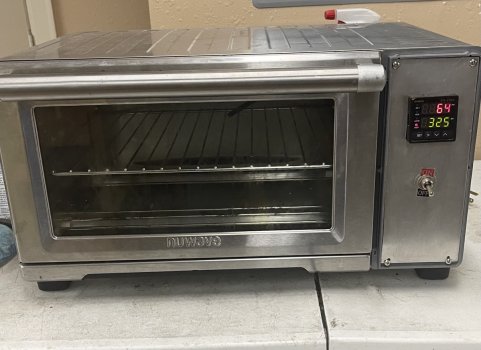CDHumiston
Well-Known Member
As many of you read in my prior thread on tempering ovens I went out and bought an expensive drying oven. Well, it failed miserably. The oven died on the second use with the on/off switch failing and getting stuck in the on position. Shortly after that the oven died completely. The return process was very slow and painful as the selling company was a US based Chinese firm. They finally agreed to take the oven back, but I had to drive nearly 100 miles to return it myself. The online company is Toolots. I'd suggest everyone stay away from them.
The good news is, my wife and I were going to yard sales yesterday and I found a commercial cookie making oven. It has nothing but an on/off switch and no other controls. The manual stated it was set for a very stable 325. However, when I brought it home and tested it the temp stabilized at 275. It was very accurate and never varied by more than 2 degrees.
I only paid $5 for the oven, and I found it multiple places online from $150 to $1000 in various used to new states. Mine looks barely used. I decided to take it apart and try to see if I could do anything to increase the temps. The first thing I found is the oven has a very well-made heat regulating system and lo and behold there was an adjustment screw! I adjusted it up, put it back together and ran another test. I went too far, and the new stabilized temp was 425. After about 5 times taking the front panel off and making small adjustments, I finally got it to 310 which is good for me. I use stainless almost exclusively and AEB-L and 440C more than anything else.
Needless to say, I am very happy with the $5 purchase and at some point, I may install a PID controller.
The good news is, my wife and I were going to yard sales yesterday and I found a commercial cookie making oven. It has nothing but an on/off switch and no other controls. The manual stated it was set for a very stable 325. However, when I brought it home and tested it the temp stabilized at 275. It was very accurate and never varied by more than 2 degrees.
I only paid $5 for the oven, and I found it multiple places online from $150 to $1000 in various used to new states. Mine looks barely used. I decided to take it apart and try to see if I could do anything to increase the temps. The first thing I found is the oven has a very well-made heat regulating system and lo and behold there was an adjustment screw! I adjusted it up, put it back together and ran another test. I went too far, and the new stabilized temp was 425. After about 5 times taking the front panel off and making small adjustments, I finally got it to 310 which is good for me. I use stainless almost exclusively and AEB-L and 440C more than anything else.
Needless to say, I am very happy with the $5 purchase and at some point, I may install a PID controller.

